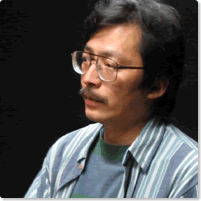The Attic
(2002)
photo by Taku Ohara
Data
:
First Performance: 2002
Performance time: 2 hours
Acts / Scenes: 23
Cast: 16 (11 men, 5 woman)
Yoji Sakate
The Attic

Yoji Sakate
Born in 1962, Sakate started the Theatre company RINKO-GUN in 1983. He has been in charge of the writing and directing for almost all this troupe\’s works since that time. In 1999, he studied in New York on an ACC grant. Sakate has also engaged in writing and directing outside the troupe, and has issued a number of collections of his criticism and plays. He has served as Director of the Japan Playwrights Association for ten years and as Director of the Japanese Theatre Directors Association, and as Director of the Japanese Centre of the International Theatre Institute. Sakate considers drama to be a variety of media and explores social problems from a journalistic perspective through themes of the conflict between the social collective and the individual. He has taken up such topics as the Okinawa issue, the Japanese Self-defense Force, religious issues, and so on. At the same time, Sakate has produced a series of exchanges with other genres, such as dance, music, and films, as well as a serial work about Yakumo Koizumi (the Japanese name of Lafcadio Hearn) that incorporates contemporary Noh forms. He has also been active internationally, with performances in 27 cities in 15 overseas countries, joint works with artists in other countries, and so on. He is the recipient of numerous directing and literature awards including the Kishida Drama Award, The Tsuruya Namboku Drama Award, the Yomiuri Literature Award the Kinokuniya Theatre Award, the Asahi Arts Award and the Outstanding Director Award of the of the Yomiuri Theatre Grand Prix, among others.
Theatre company RINKO-GUN
https://rinkogun.com/

An “Older Brother” visits a university dormitory. He enters a small indoor cubicle assembled from a simple kit called an “Attic.” It was here that his “Younger Brother” withdrew from the world for five months before committing suicide. Unable to accept his brother’s death, Older Brother sets out on a journey to find the inventor of the Attic.
A “Young Girl” who refuses to go to school anymore because of bullying has withdrawn into an Attic set up on the veranda of her home. A “Young Boy” goes to visit her holding secret desires and motives, but he is turned away. Still, the girl begins to read a copy of
The Diary of Anne Frank
that the boy had left her and it leads her to the realization that she is indeed “a free person.”
In an Attic buried in the garden of a home lies the “Corpse” of a man. For years the man had withdrawn from the world, having rental videos and the Internet as his only connections to the outside world. Before his eyes, videos—detective stories, period dramas and war movies—play on like an unending nightmare. He calls for help from the “Attic Hunter,” who is the incarnation of a figure in the graffiti on the Attic walls. But all the Attic Hunter can do is give consolation to the dead Corpse.
A “Young Woman” who has acquired the same Attic in which Younger Brother died, claims that she is pregnant and seeks to shut out all possible sources of allergies. Troubled by her obsession, her husband returns the Attic. Going to the department store everyday so that she can spend time in her former Attic, Young Woman is also fated to call forth the Attic Hunter.
In order to find the creator of the Attic, Older Brother becomes a counselor of people who have withdrawn from the world. To his patients, Older Brother talks about his memories of his Younger Brother, who had always been a model student.
In a dream the Corpse sees his mother commits suicide. Soon a “war movie,” the one remaining video the man has not seen, will begin to play.
The teacher of the Young Girl who refuses to go to school comes to visit her. When the teacher begins to cry out that she is being bullied too, the girl shows her a small planetarium.
As the Attics gradually become a social problem, Older Brother is led by the Attic Hunter into another world where he finally meets the inventor of the Attic, the “Man on Crutches.” The Man on Crutches is also an “older brother” who lives together with a “younger brother” who has lost the ability to speak. The self-portrait that this younger brother draws on the walls of the Attic where he is bedridden is none other than the Attic Hunter.
Directed by the Man on Crutches, Older Brother tells this younger brother to draw a larger self-portrait in a ritual to call forth the Attic Hunter. When the ritual is complete, what appears before Older Brother is his Younger Brother in the form of the Attic Hunter. It is a realization that the promised place where the two brothers will meet is the old familiar attic.
Related Tags

